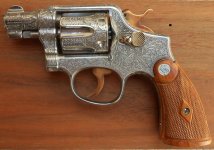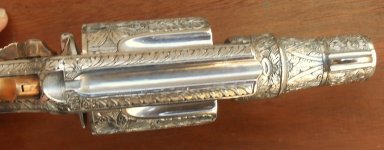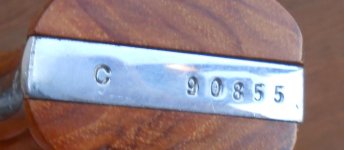I picked-up this engraved 2" M&P today. It's been shot before.
There is no initials or anything else I can see (even under the stocks) that would give me a clue on who might have engraved it. Sort of a floral pattern I guess.
The serial is: C 90855
There are no numbers on the stocks at all. I assume they were chosen to replace the original stocks and complement the engraving.
Everything else matches the butt as it should. The barrel, star, and cylinder face all match.
There is what appears to be a KO 9 above the assembly number on the frame but I don't think it means anything.
I guess it was made some time in the late 1940s to around 1950.
It had been sitting at a local shop for at least 18 years. The owner passed eight years ago so nothing was known about it.
It was priced at $2900.00 by the owner but the best offer they ever got for it since he passed was $1900.00.
I traded a Victory model and a couple of US .22 Training rifles for it....I had extras of them all anyway.
Anyone recognize the engraving?
There is no initials or anything else I can see (even under the stocks) that would give me a clue on who might have engraved it. Sort of a floral pattern I guess.
The serial is: C 90855
There are no numbers on the stocks at all. I assume they were chosen to replace the original stocks and complement the engraving.
Everything else matches the butt as it should. The barrel, star, and cylinder face all match.
There is what appears to be a KO 9 above the assembly number on the frame but I don't think it means anything.
I guess it was made some time in the late 1940s to around 1950.
It had been sitting at a local shop for at least 18 years. The owner passed eight years ago so nothing was known about it.
It was priced at $2900.00 by the owner but the best offer they ever got for it since he passed was $1900.00.
I traded a Victory model and a couple of US .22 Training rifles for it....I had extras of them all anyway.
Anyone recognize the engraving?





